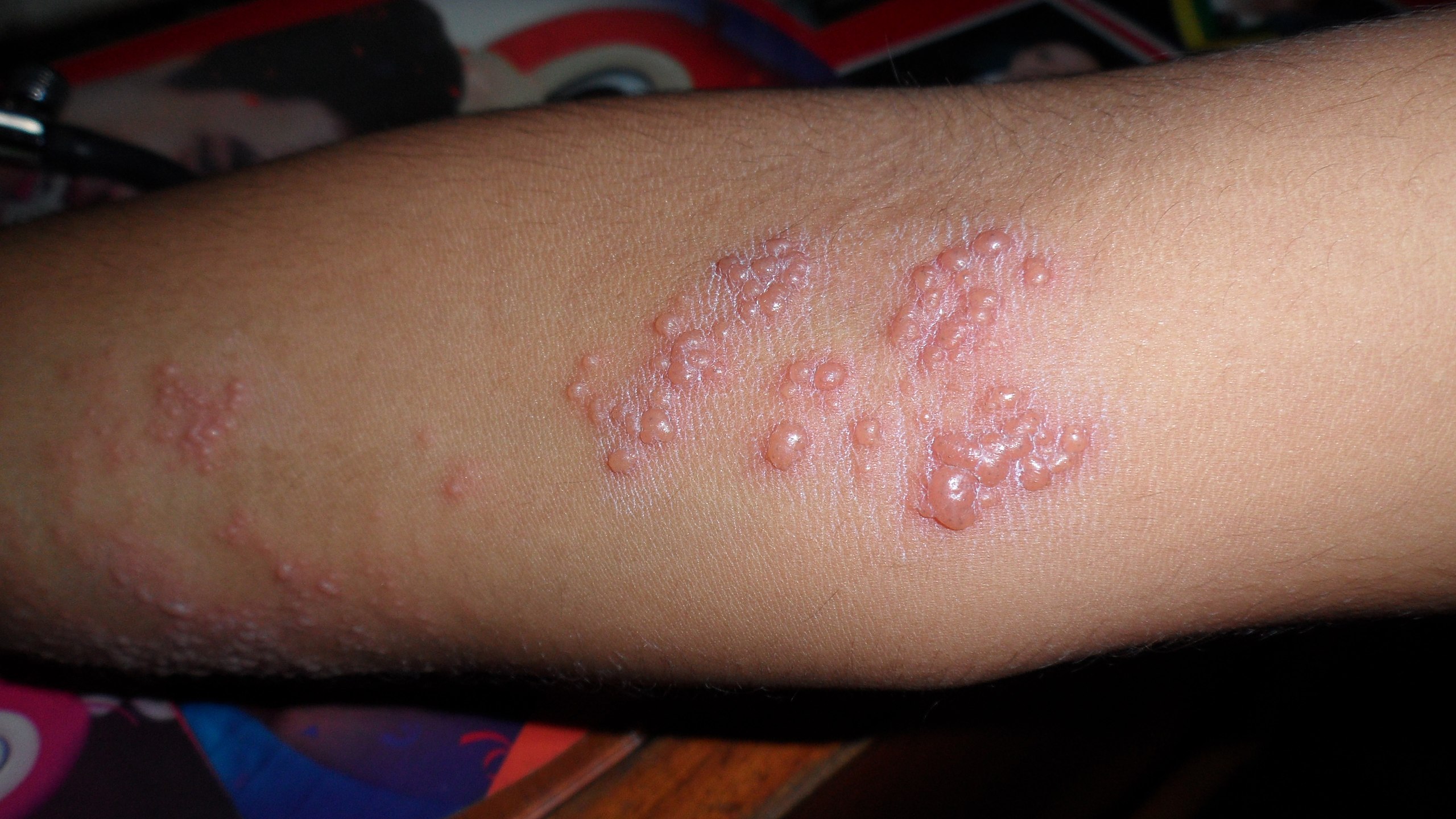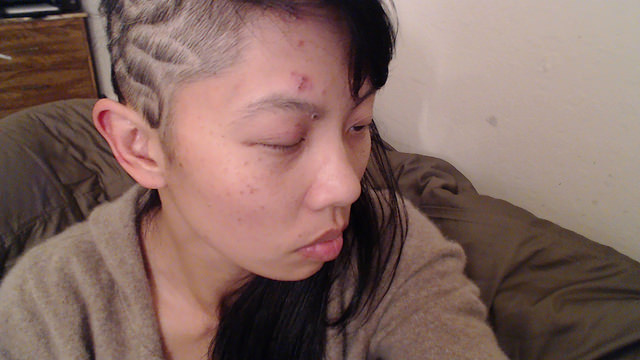Difference Between Chickenpox and Shingles
The infection with varicella-zoster virus (a representative of the group of herpes viruses) occurs under two clinical forms – chickenpox and shingles.
In the initial infection with the virus develops chickenpox. The infectious agent remains latent in the nerve ganglia of the body. Under certain conditions, the virus can be reactivated and shingles can be induced.

What is Chickenpox?
Chickenpox is one of the most common infections in childhood. All ages are susceptible to the disease, but it is much more severe in adults.
People are the only reservoir of varicella-zoster virus. The transmission of the virus is by an air-droplet pathway. The contagion occurs when droplets containing the virus, formed by the sneezing or coughing of an infected person, fall in the airways or the eyes of other people. In case of contact with patients with shingles, the virus can be transmitted if infecting material falls in the respiratory tract or conjunctivitis of the eye. Another way of transmitting the infection is intrauterine during pregnancy.
Upon contact with a patient with chicken pox, 80% of the people who have not suffered from it get ill.
The virus enters the body via the respiratory system and the conjunctiva. Through them, it falls into the bloodstream and reaches all tissues and organs, including the skin. There it causes characteristic changes in epithelial and subepithelial cells and the appearance of a rash. The incubation period of chickenpox is between 12 and 21 days. The patients are most contagious 1-2 days before a rash occurs.
The symptoms of the disease start abruptly. The temperature rises to 39◦C and a characteristic rash appears, starting from the corpse and always affecting the hairy part of the head. On the face the rash is scarce, at the palms and soles, it is almost missing. The rash is accompanied by strong and persistent itching. At the beginning, small reddish round spots appear on the skin. They are called macules. Gradually, they rise above the skin and evolve in papules. After a few hours, the papules evolve to vesicles – small bubbles filled with transparent liquid content. The vesicles are localized on all mucous membranes in the oral cavity, the genitals, and the conjunctiva. After 1-2 days the vesicles are cracked, the secretion dries up and forms a brownish crust that drops after about 2 weeks.
After the chickenpox disease, sustained immunity is obtained. Repeated illness is observed in 1% of the patients.
 What is Shingles?
What is Shingles?
Approximately 10-20% of the patients, which have had chickenpox, develop shingles later in life as a result of a recurrence of the virus. The reasons for the recurrence of the virus are most often reduced immunity and / or re-encounter with the virus (contact with a person with chickenpox).
The shingles proceeds with very severe pain and rash. The rash affects a skin area innervated from a particular peripheral nerve.
There may be so-called pre-existing symptoms such as fatigue, muscle pain, burning, and tingling in the area of the skin, which will later be affected by the rash. This can be accompanied by fever. With or without previous symptoms, burning pain occurs in a broad area of the skin of the body or face (depending on the affected nerve). The pain may be burning, sharp or dull.
Usually, about 1 to 3 days after the onset of the pain appears a characteristic rash. At this stage, the patient is most contiguous. By the seventh day from the beginning of the disease, the vesicles are cracked, the secretion dries up and forms a brownish crust.
Unlike chickenpox, the shingles’ rush is always one-sided and consists only of grouped vesicles with a clear content, located on a red-colored base. They are localized on skin that is innervated by a particular nerve. The most frequently affected skin areas are those innervated by nervus trigeminus, nervus facialis, and intercostal nerves.
Possible complications of the shingles infection are damage to vision and hearing as well as post- shingles neuralgia – severe pain in the affected area, continuing for a long time after the skin rash disappears.
The treatment of shingles virus infection depends on the severity of the disease. For mild and moderate forms, symptomatic treatment is given – against fever, itching or pain. Severe forms of the disease require the use of antiviral drugs or immunoglobulins.
Most people suffering from shingles are over 50 years of age or have a weakened immune system. Usually, after shingles, there is no second episode of development of the disease, which implies building up immunity. In patients with severely impaired immune system, a tendency to repeated, multiple occurrences of shingles are observed.
Difference Between Chickenpox and Shingles
Definition
Chickenpox: Chickenpox is a contagious disease caused by infection with varicella-zoster virus.
Shingles: Shingles is an infection of a nerve and the skin around it, caused by the reactivation of the varicella-zoster virus.
Age of the patients
Chickenpox: All ages are susceptible to chickenpox, but it is much more common in children.
Shingles: The shingles occurs in adults.
Transmission
Chickenpox: The transmission of the virus is by an air-droplet pathway. The contagion occurs when droplets containing the virus, formed by the sneezing or coughing of an infected person, fall in the airways or the eyes of other people.
Shingles: After chickenpox, the infectious agent remains latent in the nerve ganglia of the body. Under certain conditions, the virus is reactivated and shingles is induced.
Type of the infection
Chickenpox: The chickenpox is a primary infection.
Shingles: The shingles is a reactivation of old infection.
Symptoms
Chickenpox: The symptoms of chickenpox are fever and itching rash. The rash appears, starting from the corpse and always affects the hairy part of the head. On the face the rash is scarce, and at the palms and soles it is almost missing.
Shingles: Pre-existing symptoms such as fatigue, muscle pain, burning, and tingling in the area of the skin, which will later be affected by the rash may occur. This can be accompanied by fever. The shingles proceeds with very severe pain and rash. The rash affects a skin area innervated from a particular peripheral nerve.
Rash
Chickenpox: Itching, non-grouped vesicles.
Shingles: Painful, grouped vesicles.
Complications
Chickenpox: The chickenpox is rarely complicated.
Shingles: The shingles may lead to complications more often.
Summary of Chickenpox Vs. Shingles
- The infection with varicella-zoster virus (a representative of the group of herpes viruses) occurs under two clinical forms – chickenpox and shingles.
- Chickenpox is a contagious disease caused by infection with varicella-zoster virus.
- Shingles is an infection of a nerve and the skin around it, caused by the reactivation of the varicella-zoster virus.
- All ages are susceptible to chickenpox, but it is much more common in children. The shingles occurs in adults.
- The transmission of the virus in chickenpox is by an air-droplet pathway. The contagion occurs when droplets containing the virus, formed by the sneezing or coughing of an infected person, fall in the airways or the eyes of other people.
- After chickenpox, the infectious agent remains latent in the nerve ganglia of the body. Under certain conditions, the virus is reactivated and shingles is induced.
- The chickenpox is a primary infection, the shingles is a reactivation of old infection.
- The chickenpox rash is formed by itching, non-grouped vesicles. The shingles is formed by painful, grouped vesicles.
- The chickenpox is rarely leads to complications. The shingles may lead to complications more often.
- Difference Between Gallstones and Cholecystitis - September 5, 2021
- Difference Between Constipation and Cramping - August 4, 2021
- Difference Between Whole Genome Sequencing and Microarray - May 6, 2021
Search DifferenceBetween.net :
Leave a Response
References :
[0]Image credit: https://www.flickr.com/photos/elleko/16283393820
[1]Image credit: https://he.wikipedia.org/wiki/%D7%97%D7%99%D7%A1%D7%95%D7%9F_%D7%A0%D7%92%D7%93_%D7%90%D7%91%D7%A2%D7%91%D7%95%D7%A2%D7%95%D7%AA_%D7%A8%D7%95%D7%97#/media/File:Herpes_zoster,_elbow.jpg
[2]Arvin, A., A. Gershon (eds). Varicella-Zoster Virus: Virology and Clinical Management. 1st Edition. Cambridge: Cambridge University Press. 2000. Print.
[3]Hyman R. Natural History of Varicella-Zoster Virus. Toronto: CBC Press. 1987. Print.
[4]Silverstein A., V. Silverstein, L. Silverstein Nunn. Chicken Pox and Shingles.1998. Berkeley Heights: Enslow Pub Inc. Print.

